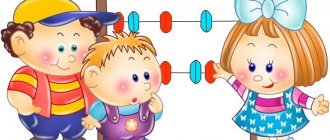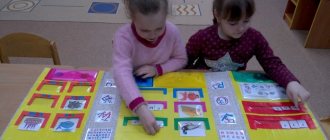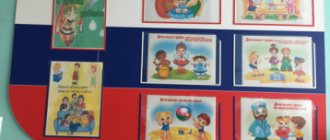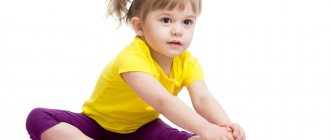Master class on making a lapbook “My home, my family”
Galina Serebryanskaya
Master class on making a lapbook “My home, my family”
Lapbook : "My home, my family "
I would like to bring to your attention a master class : lapbook “My home, my family ”
To make it I needed :
- Crochet hook
Lapbook “My Family”
Tatiana Stepanova
Lapbook “My Family”
The educational guide lapbook “My Family” is a cardboard folder on the pages of which there are various pockets, cards that contain information, tasks, and games on the topic.
The purpose of the lapbook: to clarify and expand students’ ideas about family members and their professions.
Scope of application: all educational areas.
Forms and methods of implementation:
Verbal methods: method of creative conversation, story.
Visual methods: educational demonstration, methods of modeling situations.
Practical methods, games.
Age of students: preschool age (this manual is aimed at younger children; in the future it will be changed and replenished in accordance with the age of the students).
Results:
In the process of games and activities with an interactive manual, the vocabulary is activated, speech develops, and children show interest in didactic games. The child’s thinking, imagination, and creative abilities develop. Trusting, partnership relationships are formed between educators, students and their parents.
The lapbook “My Family” I created includes various tabs and pockets with educational games, manuals, visual diagrams, and demonstration materials, namely:
- D/i “Help grandma patch the rug”;
— D/i “Collect a family tree”;
— Professions of family members;
“Family and us” At the present stage of work of a preschool institution, the most relevant topic is interaction and cooperation with the families of pupils. In our. Album “My Family” Probably, in almost every garden they are working on the “My Family” project. After all, this topic is very important for a child. We also developed our own. Photo report “Happy is he who has a family. I and my family. “Clean Entrance” campaign Neighbors can often seem nice and smiling in public. But smile or don’t smile, but the trash in the entrance still catches your eye. Information and game lapbook “Family” Goal: To increase the interest of parents and children in family values and traditions. Objectives: To form a correct idea of the mother’s role in the family. Abstract of the educational activity “This is me, this is me, this is my whole family” Educational areas: “Cognitive development”, “Social and communicative”, “Artistic and aesthetic development” Goals • To educate. Lapbook “Me and my family” I bring to your attention and evaluation the Lapbook (interactive folder) on gender education “Me and my family”. I started by trimming and...
Methodological recommendations for using the developmental didactic manual lapbook “My Family”
Relevance of the manual
At preschool age, the formation of cultural and value orientations, the spiritual and moral basis of the child’s personality takes place, the development of his emotions, feelings, thinking, mechanisms of social adaptation in society, and the process of self-awareness in the world around him begins.
This period in a person’s life is the most favorable for emotional and psychological impact, since the images of perception of reality are very vivid and strong and therefore they remain in memory for a long time, and sometimes for a lifetime.
The family is of great importance in solving these problems. After all, family values are the principles on which our lives are based; they are the standards by which we judge what is right and what is wrong. It is in the family that a child develops a sense of love and affection for his home, family, family traditions and customs. Unfortunately, the diagnostic results show that children do not have clear ideas about the concepts of “family”, “family members”, about the family tree, and have poorly formed ideas about the professions of their parents and the importance of these professions in society. Many children cannot describe the importance of family for a person. Parents also underestimate the importance of family traditions in raising their children. The need to create a methodological manual “My Family” was due to the above factors.
Didactic manual lapbook “My Family” is made in the form of a house, with opening doors. Inside the house there are pockets in which there are games on the theme “family”. All pockets are easily removable and can be used with different subgroups of children.
The didactic manual is designed for children aged 3 to 7 years. is a means of developing children's education. This manual helps the child choose a game at will in order to better understand and remember the material.
Expected result from using this teaching aid in the preschool education system:
- children learn more about their family: about family members, traditions, about the life of grandparents;
- children will learn to maintain a conversation and express their point of view;
— successful interaction will be established between teachers and parents, which will allow each other to provide the necessary support in the development and upbringing of the child.
The positive aspect is:
— individuality in work;
— simultaneous coverage of children from one to five children;
- can be used in different types of activities;
- mobile;
- is a striking attribute in a subject-development environment.
Goal : developing an idea of a family as people who live together, hobbies, family values; developing a sense of pride in one’s family and a desire to care for loved ones in the family.
The didactic manual allows you to solve problems:
Educational:
— expand children’s understanding of the concept of “Family” through games and various activities;
— to form ideas about morality and spiritual development of the individual through family values;
— develop skills of cooperation and mutual understanding;
- develop creative and cognitive activity through the joint work of an adult and a child.
Educational:
- develop speech activity in children, introduce the following concepts into the active vocabulary: “family, relatives, close ones”, encourage reasoning;
- develop fine motor skills;
- develop emotional responsiveness.
Educational:
— cultivate love and respect for family members;
— create an atmosphere of mutual understanding, common interests, and emotional support.
— increase the active participation of parents in the life of the group.
This manual can be used in working with children in the following educational areas:
— cognitive development;
- speech development;
— social and communicative development;
- artistic and aesthetic development.
The “My Family” lapbook includes the following games:
Didactic game “How I grow”
Goal : to teach children to determine the gender of the person depicted in the picture; Expand words knowledge; develop thinking.
Game description
Invite the child to look at three pictures, name who is drawn (girl, aunt - mother, grandmother). Ask the child who is younger and who is older.
Encourage your child to answer in complete sentences. When first introducing the game, help your child put the pictures in order, and then encourage the child to act independently or with a little help.
Using these pictures, you can offer children the following tasks:
“Who is the odd one out: boy, aunt, grandfather, uncle.” Combine pictures according to a given criterion: girls - boys, adults - children.
Didactic game “My Family”
Goal : consolidate knowledge about close relatives who live in the same apartment.
Description of the game . The game is a set of figures of family members of different genders and ages. Children are invited to place family members who live in the same apartment or house and talk about them. You can count how many people are in your family, whether there are more men or women, and you can also sort family members by age, etc.
Word game “Make a sentence”
Goal : develop attention, thinking, expand the child’s vocabulary and horizons.
Description of the game.
The envelope contains story pictures on the topic “Family”. The teacher hands out pictures to the children, asks them to carefully look at the picture and make a sentence (for younger children). At an older age, children take story pictures and make up a story based on them.
Didactic game “Who is doing what?”
Goal : to consolidate children's understanding that in the family each member has his own responsibilities, which depend on age, interests and needs.
Rules for conducting a didactic game:
1. Number of participants from 2 to 6 children.
2. Pictures are selected by each player in turn.
3. The choice of picture is accompanied by an explanation of why this particular family member should perform certain duties.
4. In one move, the child can take only one picture.
Game description
Distribute pictures depicting family members among the players. Children are asked to select tools for each family member, explain what can be done with them, for what purpose: who else can do this work.
Everyone who selected the most pictures and gave a meaningful explanation won.
Family Tree Game
Goal: to consolidate knowledge about yourself, about your family tree, pedigree, to expand your understanding of family, to learn how to navigate family relationships.
Game description
The child is asked to place family members on the tree, tell them their names, who is related to whom.
Game “Whose things are these?”
Goal: The ability to distinguish between things that belong to adults and children.
Tasks:
Educational: Form a grammatical structure through mastery of the morphological structure of speech and word formation. Exercise children in the formation of possessive adjectives. Explain the meaning of the generalized word family.
Developmental: Develop dialogical speech, memory, thinking.
Educational : Foster mutual assistance to each other.
Materials and equipment: pictures depicting family members: mother, father, children (girls and boys), grandparents are glued to clothespins. Pictures of household items: clothes, dishes, toys, school supplies, etc. are placed on a circle.
Game description
Children are given circles with images of objects. Children need to place a family member who owns these things next to each one. The child must explain why he made this choice. The one who completes the task faster wins.







